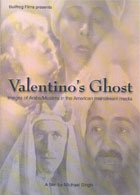
Valentino’s Ghost: Images of Arabs/Muslims in the American Mainstream Media 2011
Distributed by Bullfrog Films, PO Box 149, Oley, PA 19547; 800-543-FROG (3764)
Producer n/a
Directed by Michael Singh
DVD, color, 52 min.
College - General Adult
Journalism, American Studies, Middle Eastern Studies, Media Studies, Film Studies
Date Entered: 03/01/2012
Reviewed by Oksana Dykyj, Head, Visual Media Resources, Concordia University, MontrealValentino’s Ghost, chronologically situates the American representation of Islam, Muslims and Arabs from the 1920s onward through interviews and clips from various media. Just like other marginalized groups such as African Americans, Asian Americans, Native peoples and other non-visible minorities, Muslim and Arab depictions in media follow similar paths in terms of individuals being grossly caricatured and reduced to physical attributes while being considered the “other.” The cataloguing of the various types of stereotypical good Arabs and bad Arabs presented in the film has already been adequately detailed in Reel Bad Arabs: How Hollywood Vilifies a People. There is some overlap between the two documentaries, and while the earlier one is more focused on motion picture stereotypes, Valentino’s Ghost expands the field to include most media and popular culture. This is, in fact, where this documentary truly excels.
The minor but unfortunately glaring flaw in the documentary revolves around some statements presented by interviewees that are rather sloppy academically. How can a statement such as, “The Sheik would create the most popular male sex symbol in the history of American Cinema” possibly be supported by appropriate data? Has not one other actor surpassed Rudolph Valentino’s brief appeal in the last 80 years? Clearly, the historian should have added a sentence to clarify that her comment accounted for only the period until Valentino’s death, or in the 1920s. Similarly, in relation to T.D. Lawrence (aka Lawrence of Arabia) she states: “Lowell Thomas’ vivid photos and film created America’s first mass media superstar.” Again, a statement such as this is not only erroneous but rather short sighted and completely incomprehensible coming from an academic who happens to also be a historian. A little more clarification on the part of the speaker would have explained her position more adequately. Luckily, the documentary heartily transcends this lack of precision from one of its specialists and provides a well-developed history of American politics vis-à-vis Israel since the late 1970s. It addresses the repercussions in relation to Palestine and poses the correct questions about policy and U.S. – Israel relations. These sections are the most valuable and engaging in the film. This documentary, despite some minor problems, posits well developed ideas about Arab representation and relates them to politics and popular culture. It will promote substantial discussion, which is important for such a significant topic. Recommended.